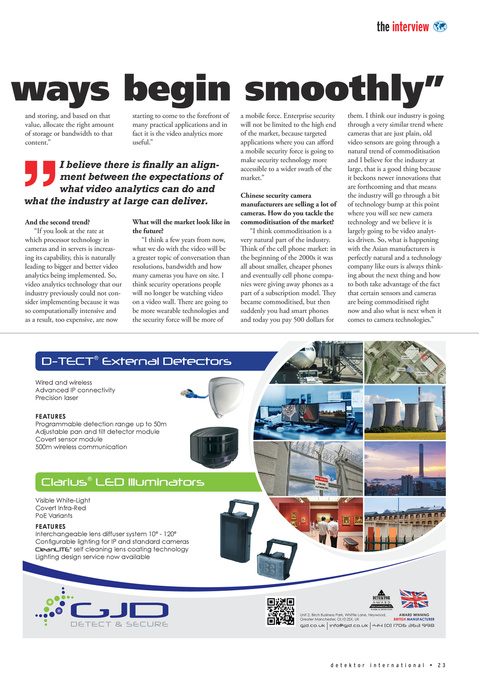- Page 1
- Page 2
- Page 3
- Page 4
- Page 5
- Page 6
- Page 7
- Page 8
- Page 9
- Page 10
- Page 11
- Page 12
- Page 13
- Page 14
- Page 15
- Page 16
- Page 17
- Page 18
- Page 19
- Page 20
- Page 21
- Page 22
- Page 23
- Page 24
- Page 25
- Page 26
- Page 27
- Page 28
- Page 29
- Page 30
- Page 31
- Page 32
- Flash version
© UniFlip.com
- Page 2
- Page 3
- Page 4
- Page 5
- Page 6
- Page 7
- Page 8
- Page 9
- Page 10
- Page 11
- Page 12
- Page 13
- Page 14
- Page 15
- Page 16
- Page 17
- Page 18
- Page 19
- Page 20
- Page 21
- Page 22
- Page 23
- Page 24
- Page 25
- Page 26
- Page 27
- Page 28
- Page 29
- Page 30
- Page 31
- Page 32
- Flash version
© UniFlip.com

the interview
ways begin smoothly”
and storing, and based on that value, allocate the right amount of storage or bandwidth to that content.” starting to come to the forefront of many practical applications and in fact it is the video analytics more useful.”
I believe there is finally an alignment between the expectations of what video analytics can do and what the industry at large can deliver.
And the second trend? “If you look at the rate at which processor technology in cameras and in servers is increasing its capability, this is naturally leading to bigger and better video analytics being implemented. So, video analytics technology that our industry previously could not consider implementing because it was so computationally intensive and as a result, too expensive, are now What will the market look like in the future? “I think a few years from now, what we do with the video will be a greater topic of conversation than resolutions, bandwidth and how many cameras you have on site. I think security operations people will no longer be watching video on a video wall. There are going to be more wearable technologies and the security force will be more of
a mobile force. Enterprise security will not be limited to the high end of the market, because targeted applications where you can afford a mobile security force is going to make security technology more accessible to a wider swath of the market.” Chinese security camera manufacturers are selling a lot of cameras. How do you tackle the commoditisation of the market? “I think commoditisation is a very natural part of the industry. Think of the cell phone market: in the beginning of the 2000s it was all about smaller, cheaper phones and eventually cell phone companies were giving away phones as a part of a subscription model. They became commoditised, but then suddenly you had smart phones and today you pay 500 dollars for
them. I think our industry is going through a very similar trend where cameras that are just plain, old video sensors are going through a natural trend of commoditisation and I believe for the industry at large, that is a good thing because it beckons newer innovations that are forthcoming and that means the industry will go through a bit of technology bump at this point where you will see new camera technology and we believe it is largely going to be video analytics driven. So, what is happening with the Asian manufacturers is perfectly natural and a technology company like ours is always thinking about the next thing and how to both take advantage of the fact that certain sensors and cameras are being commoditised right now and also what is next when it comes to camera technologies.”
D-TECT® External Detectors
Wired and wireless Advanced IP connectivity Precision laser FEATURES Programmable detection range up to 50m Adjustable pan and tilt detector module Covert sensor module 500m wireless communication
Clarius® LED Illuminators
Visible White-Light Covert Infra-Red PoE Variants FEATURES Interchangeable lens diffuser system 10º - 120º Configurable lighting for IP and standard cameras CleanLITE® self cleaning lens coating technology Lighting design service now available
Unit 2, Birch Business Park, Whittle Lane, Heywood, Greater Manchester, OL10 2SX, UK
AWARD WINNING BRITISH MANUFACTURER
gjd.co.uk
info@gjd.co.uk
+44 (0) 1706 363 998
Detektor International Half Page FEB.indd 1
01/02/2017 14:41
dete kto r
in te r nat i on al
•
23